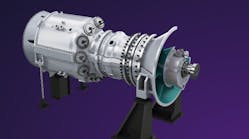Hydrogen blending test completed at Michigan Gas-Fired Power plant using Wärtsilä engine
H2 may have cleared a key hurdle toward the goal of decarbonizing the baseload power sector, but we may not know for a while.
A Michigan gas-fired power plant has carried out significant testing with hydrogen blended into the fuel mix, engine supplier Wärtsilä reported this week.
The tests were conducted at utility WEC Energy Group’s 55-MW A.J. Mihm power plant in Pelkie, using an 18-MW Wärtsilä 50SG engine. Other partners in the testing include Certarus, which supplied the hydrogen and blending skid, WEC Energy, Electric Power Research Institute and Burns & McDonnell.
The Wärtsilä engine continued to deliver power to the electric grid during the testing period, according to the report. The full report on findings will be published early next year.
The energy industry is exploring the possibilities of hydrogen, which does not contain carbon within its molecular chain.
“While we continue to work on making pure hydrogen fuel a viable option, I believe that this testing project reinforces Wärtsilä’s leading position in the development of technology using sustainable fuels,” Kai Janhunen, the Finnish company’s vice president for engine power plants, said. “The results have been outstanding, and no technical modifications whatsoever were needed to be made to the Wärtsilä 50SG engine.
“Decarbonization is a central issue for today’s global energy sector, and these tests move us a little closer to reaching it,” Janhunen added.
Many original equipment manufacturers such as Siemens and Mitsubishi Power are also exploring the potential of H2 to decarbonize the gas-fired power turbine and engine mix. The latter, for instance, is involved in the Intermountain Power Project and Advanced Clean Energy Storage hydrogen storage project in Utah.
Methane natural gas, which already accounts for nearly 40 percent of U.S. power generation fuel resources, emits about half the carbon dioxide of coal-fired power, but emissions goals are pushing government and private sectors to do more while still ensuring grid resiliency.
Nov. 30 InfoGrid webinar: Energy Efficiency in the Built Environment
A Revolution in Commercial Real Estate: Register here
World Hydrogen North America: Moving H2 beyond Hype Squared
Subscribe to EnergyTech's free email newsletter for more Insights into the C&I Energy Transition
Concerns about hydrogen are focused around its volatility and impact on combustion chambers and other equipment within the power generation apparatus. Hydrogen is the lightest element in the chain, highly flammable, more easily dispersed and escapable without detection, according to some warning reports.
Wärtsilä, meanwhile, is actively carrying out tests with 100-percent hydrogen fuel at the company’s engine laboratory in Vaasa, Finland. Company leaders have expressed hopes for an engine and power plant operating on pure hydrogen by 2025.
Another challenge around hydrogen is producing it, since it is not readily available by mining or drilling. It must be extracted either by steam reforming of methane natural gas, which is carbon intensive, or by electrolyzers which use electricity to separate the H2 from water.
To be considered truly green hydrogen, or carbon-free H2, it must be generated by electrolyzers powered by renewable or zero-carbon generation such as solar, wind, hydropower and nuclear.
Research firm MarketsandMarkets has forecast that the hydrogen energy storage sector could rise by an annual rate of 54 percent and total more than $119 billion annually by 2027.
White paper: Economic & Environmental Improvements w/ PEM Electrolyzers: Nafion
-- -- --
(Rod Walton, senior editor for EnergyTech, is a 14-year veteran of covering the energy industry both as a newspaper and trade journalist. He can be reached at [email protected]).





